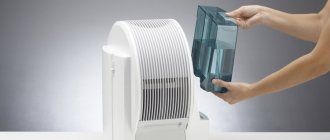The advent of SSDs has shaken the monopoly of hard drives. Most laptops today come with solid-state drives.
At the same time, it is still too early to write off classic hard drives; in some cases, installing an HDD is preferable and more profitable.
If you are in a hurry and want to immediately find out the best offers in each rating category from different online stores , you can familiarize yourself with the table and see the current prices on the Yandex.Market service by clicking on the “find out price” button in the table opposite the model.
Rating of the TOP 8 best hard drives (HDD) for a laptop
| Place | Model | Price |
| The best hard drives for a 500 GB laptop | ||
| #1 | Western Digital WD5000LPLX | |
| #2 | Seagate 500 GB ST500LM021 | |
| #3 | Toshiba 500 GB HDWK105UZSVA | |
| The best 1000 GB models | ||
| #1 | Western Digital WD10SPZX | |
| #2 | Toshiba 1TB HDWL110UZSVA | |
| #3 | Western Digital WD10SPCX | |
| The best HDDs for a 2000 GB laptop | ||
| #1 | Western Digital WD20SPZX | |
| #2 | Toshiba 2 TB HDWL120UZSVA | |
Page navigation:
What are HDD and SSD
HDD (Hard Disk Drive), or hard drive, is a device for recording magnetic information. Data is recorded on aluminum or glass plates that are coated with a layer of ferromagnetic material. Chromium dioxide is usually used. One axis, called a spindle, uses one or a pair of plates.
Information from the surface of the disks is read using special heads. An electric motor with a separate drive for each disk is used for rotation. The data is recorded in thin tracks, like on a vinyl record, but not from edge to center, but from center to edge.
The principle of storing information is based on binary code, which is used by all computers without exception. The non-magnetized sector encodes a zero, and the magnetized one encodes one. With the help of other hardware and software, the data is decoded into a form understandable to the computer user.
In operating mode, the read heads do not touch the surface of the disks. This reduces operating noise and ensures longer service life. A head falling onto the surface of a magnetic disk is a serious defect, for which you should contact a service center to eliminate it. As a rule, such a drive cannot be repaired, but engineers can help recover lost data. A special microcircuit is responsible for synchronizing the operation of the components.
In 2021, despite the development of data storage technologies, the hard drive continues to hold its leading position as a local storage device. An alternative, but not a competition, is SSD - solid state drives. The operating principle of such devices is different. These are memory chips that use crystals to store data. The principles of data recording are also different, so such drives do not require defragmentation.
The main advantage of SSDs is their much higher operating speed compared to traditional hard drives. But the price of such storage media is much more expensive.
Such devices are based on non-volatile NAND memory. The cost of an SSD is influenced by the specific type of memory used. Modern SSDs come in three types:
- SLC - single-level. Each cell can rewrite data up to 100,000 times. The most expensive type of memory used.
- MLC - two-level. Information can be rewritten 3,000 to 5,000 times. Average cost type of cells.
- TLC - three-level. Designed for 1,000 rewrite cycles. The cheapest.
The main disadvantage of solid-state drives is that their lifespan is significantly shorter compared to traditional hard drives. Approaching a critical point, the disk begins to work intermittently and glitches, and when it reaches it, as a rule, it fails.
Recommendations for choosing a laptop hard drive
Important! Laptops support 2.5 inch internal HDDs. In addition, when choosing, you should pay attention to the following points:
- Connection interface. The ancient IDE remains only in very old devices. Modern laptops are equipped with a SATA connector, most often the third version. A hard drive with SATA 3 will also work in a laptop with SATA 2 support, but at a reduced speed.
- Rotational speed. The most common discs are with 5400 and 7200 rpm (revolutions per minute). The higher the spindle spin, the faster the disk works. But high-speed HDDs make a lot of noise, heat up and are expensive.
- Disk space volume. HDD capacity for laptops can vary widely, starting from 256 GB. The minimum option is suitable for installing an operating system, installing programs and storing a relatively small amount of user data. The best option for a laptop would be to purchase a HDD from 500 GB to 2 TB for all needs.
- Read/write speed. The higher this parameter, the faster the OS will load, launch programs, copy and move files. Manufacturers do not always indicate such data, but the results of independent tests for a specific model are available on the Internet.
- Cache memory size. The larger the cache buffer, the better. This parameter has a positive effect on overall performance.
Memory
When thinking about how to choose the right hard drive for your laptop, many people pay attention only to the capacity. Yes, this is an important criterion, but not the only one that should be paid attention to.
The selected hard drive capacity directly depends on the purpose of the computer and what you plan to do on it.
To choose a hard drive that satisfies all the requirements and tasks of a laptop, use the following recommendations:
- when the laptop is rarely used and acts as an addition to a desktop PC, you can get by with memory in the region of 320–500 GB;
- if a laptop is the main tool, then you need to start from a volume of 750–1000 GB;
- for a multimedia laptop where a lot of films, videos and other materials are stored, it makes sense to go beyond 1 TB and increase the capacity to 2–4 TB.
On laptops you can most often find 1–2 TB drives. If you need to get more, you can upgrade to drives over 4 TB. But in such a situation, it is better, if possible, to use 2 disks of 1–2 TB each than one of 4 TB. This is due to the fact that the reliability of the most capacious drives has not yet reached the desired level.
If you have financial capabilities and need, it is better to supplement your laptop with an SSD drive. And even a small volume in order to install an operating system on it. This will make the device work much faster.
ADVICE. You need to choose an SSD drive based on the fact that it is advisable to always leave about 15% of the volume free.
This protects against premature wear and increases the service life of the equipment.
The best hard drives for a 500 GB laptop
Models with a small capacity of 500 GB by modern standards are suitable for installing an operating system, programs, games, and storing user data.
TOP 3 rating of the best HDDs for a laptop in terms of price and quality ratio.
Western Digital WD5000LPLX
A hard drive is an excellent choice when upgrading a laptop to improve system speed and responsiveness, or simply to increase the overall memory capacity of the device.
This model supports the SATA 3 interface, which has a throughput capacity of 6 Gbit/s.
Increased spindle speed has a positive effect on disk writing and reading.
The built-in cache optimally distributes information between sectors of the Western Digital WD5000LPLX disk, keeping the highest priority data in memory.
This helps to increase the service life of the device and prevents errors associated with the mechanical part of the HDD.
Key parameters:
- Buffer capacity - 32 MB;
- rotation speed - 7200 rpm;
- impact resistance (operation/storage) - 400/1000 G;
- noise level (idle/operation) - 23/25 dB;
- power consumption - 2 W;
- overall dimensions (WxHxD) - 69.85x7x100.2 mm;
- weight - 92 g.
Advantages
- no vibration;
- no heating;
- compactness;
- long service life.
Flaws
- long startup after “falling asleep”;
- clicks when parking heads;
- high price.
Seagate 500 GB ST500LM021
The model, specially created for installation in laptops and ultrabooks, stands out not only for its ultra-compact dimensions, but also for its excellent speed, capacity and energy consumption.
The Seagate 500 GB ST500LM021 device has a standard 2.5-inch form factor.
Low power consumption saves battery power, allowing the user to focus on priority tasks.
The model is distinguished by high impact resistance.
When the device is turned off, the reading head instantly moves to a safe position, preventing various types of mechanical damage.
The declared service life of the hard drive is 2 years.
Key parameters:
- Buffer capacity - 32 MB;
- rotation speed - 7200 rpm;
- impact resistance (operation/storage) - 400/1000 G;
- noise level (idle/operation) - 23/24 dB;
- power consumption - 2 W;
- overall dimensions (WxHxD) - 70.1x7x100.5 mm;
- weight - 95 g.
Advantages
- low power consumption;
- high data transfer speed;
- 7200 rpm in a compact 2.5-inch design;
- affordable price tag.
Flaws
- small amount of buffer memory;
- heating during operation;
- Quite a noisy model.
Toshiba 500 GB HDWK105UZSVA
The hard drive, being a model for installation in laptops, is one of the ultra-light and thin 2.5-inch HDD drives.
The Toshiba 500 GB HDWK105UZSVA model interacts with the motherboard via a high-speed SATA 3 interface.
This hard drive is distinguished by its increased energy efficiency, sufficient disk space capacity to accommodate large amounts of data, and reduced spindle speed, eliminating strong noise and vibration during operation.
The service life of the model declared by the manufacturer is 2 years.
Key parameters:
- Buffer capacity - 8 MB;
- rotation speed - 5400 rpm;
- impact resistance (operation/storage) - 400/1000 G;
- noise level (idle/operation) - 19/21 dB;
- power consumption - 1.5 W;
- overall dimensions (WxHxD) - 69.85x7x100 mm;
- weight - 92 g.
Advantages
- very quiet operation;
- economical in terms of energy consumption;
- thin body;
- high write/read speed according to tests.
Flaws
- heating during operation;
- short service life;
- scanty buffer memory.
Manufacturers
In the case of hard drives and solid-state drives for laptops, paying a little extra for the brand will be absolutely correct. It cannot be said that leading companies greatly abuse their popularity, due to which they unfairly inflate prices.
But what is definitely not recommended to do is give preference to little-known and dubious brands. Often the stated characteristics simply do not correspond to reality. This leads to rapid failure of devices or to the desire to replace a frankly unsuccessful drive.
The manufacturer is selected based on what type of disk you plan to purchase. There are favorites in the HDD and hybrid devices segment, as well as the most preferable options for purchasing an SSD solid-state drive.
When choosing HDD hard drives and hybrid drives, you should pay attention to the following manufacturers:
- Seagate. They offer some of the fastest hard drives. But in terms of reliability, they are not as good as we would like.
- Hitachi. Their priority is reliability, stability and durability. The speed is slightly lower than that of the competitor presented above.
- Western Digital. They are positioned as the most reliable and at the same time very fast.
If a user is looking for something fast but inexpensive for a laptop, Seagate is the best option. If you need something cheap, but reliable, without a priority on speed, then Hitachi. The combination of speed and reliability is provided by Western Digital. And specifically in the black series. There are also blue ones, but they are the simplest. Other variations are intended for specific industries.
The situation with more current SSDs is different. Here the list of priority manufacturers is as follows:
- Samsung;
- SanDisk;
- Intel;
- Crucial;
- Plextor.
This is maximum quality, reliability and the best performance.
In the case of modern high-speed solid-state drives, it is highly recommended to buy products from the highest quality brand. Moreover, it’s not scary to overpay for it, and it’s even right. All companies on the list demonstrate excellent performance.
If the budget does not allow, and you need to choose something simpler, then you can consider offers from the following brands:
- Western Digital;
- Corsair;
- A-DATA;
- GoodRAM;
- Kingston.
But there are some nuances here too. Corsair, Western Digital and GoodRAM have a fairly good range of SSDs. Especially for budget drive models.
But in the case of A-DATA, it is better to focus only on the series called Premier Pro. These are the highest quality drives.
Kingston is in demand as a manufacturer of various drives. But with SSDs they are doing somewhat worse than some of their competitors. Therefore, in the case of this company, it is worth giving preference to drives sold under the name HyperX manufactured by Kingston.
You should not go beyond the companies represented. There are actually many more manufacturers. But the problem is that among them there are a lot of frankly unsuccessful projects, as well as problematic individual drive models.
By putting together all the recommendations presented, you can ultimately create a list of requirements and present them to the hard drive you are purchasing for a laptop.
Price is not a decisive factor in the case of HDDs, since the cost is practically not affected by the brand factor. The situation is different with SSDs. In addition to volume and speed, the manufacturer’s brand significantly influences pricing.
The best 1000 GB models
Due to the best price-to-capacity ratio, 1 TB hard drives are the most popular HDD category in laptops for office and home use .
Review of the best non-1000 GB models based on customer reviews and ratings.
Western Digital WD10SPZX
The model has an impressive amount of long-term memory and a 128 MB buffer device, which guarantees reliable storage of digital data arrays and minimal response time.
The device is connected to the motherboard via a high-bandwidth SATA 3 interface.
Most laptops are equipped with this technology.
Made in a 2.5-inch format, the device allows you to store up to 1 TB of information on it.
The Western Digital WD10SPZX device is very economical; at maximum load it consumes only 1.5 W of electricity.
Key parameters:
- Buffer capacity - 128 MB;
- rotation speed - 5400 rpm;
- impact resistance (operation/storage) - 400/1000 G;
- noise level (idle/operation) - 19/21 dB;
- power consumption - 1.5 W;
- overall dimensions (WxHxD) - 69.97x7x100.2 mm;
- weight - 90 g.
Advantages
- large amount of disk space;
- compact dimensions;
- low power consumption;
- excellent volume/price ratio.
Flaws
- noise and vibration during operation;
- not the most outstanding write and read speeds;
- short warranty period.
Toshiba 1TB HDWL110UZSVA
The terabyte hard drive, made in a compact 2.5-inch format, is a high-quality data storage device that can be installed in any laptop.
The model is distinguished by its reduced spindle speed, which guarantees the absence of noise during operation, and a substantial amount of cache memory.
The speed characteristics allow you to use the device as a system drive.
The Toshiba 1 TB HDWL110UZSVA hard drive has a standard case thickness and low weight. The declared service life of the model is 4 years, the warranty is 2 years.
Key parameters:
- Buffer capacity - 128 MB;
- rotation speed - 5400 rpm;
- impact resistance (operation/storage) - 400/1000 G;
- noise level (idle/operation) - 19/24 dB;
- power consumption - 1.5 W;
- overall dimensions (WxHxD) - 69.85x7x100 mm;
- weight - 92 g.
Advantages
- quiet operation;
- absence of critical temperatures;
- large buffer memory capacity;
- affordable price.
Flaws
- 2 year warranty;
- unpresentable packaging;
- low operating speed.
Western Digital WD10SPCX
Possessing an impressive amount of internal memory of one terabyte, the model allows you to install several operating systems, place their backup copies and install countless programs.
The reduced spindle speed has a positive effect on the quiet operation of this disk.
At the same time, parking the reading head and accessing information are much faster here compared to analogues.
A smart bad sector search system bypasses and blocks damaged clusters, ensuring that there is no risk of losing information on the disk.
The Western Digital WD10SPCX model interacts with the motherboard via the SATA 3 interface.
Key parameters:
- Buffer capacity - 16 MB;
- rotation speed - 5400 rpm;
- impact resistance (operation/storage) - 350/1000 G;
- noise level (idle/operation) - 20/21 dB;
- power consumption - 1.7 W;
- overall dimensions (WxHxD) - 69.85x7x100.2 mm;
- weight - 90 g.
Advantages
- relative noiselessness;
- thin slim body;
- an impressive amount of disk space;
- low power consumption.
Flaws
- frequent head parking;
- Quite slow HDD in tests;
- decent price tag.
Connectors
To choose a good HDD or SSD drive for a portable laptop, pay special attention to their interface connector. It is also the connection interface. This is the name of the connectors necessary to connect a particular drive to the motherboard via a special cable (cord, cable).
Modern HDDs use a SATA3 connector. Moreover, it is fully compatible with older versions of SATA1 and SATA2. Therefore, if there is an old connector on the motherboard, you will still be able to connect a new HDD.
If a user decides to choose an SSD hard drive for his laptop in order to speed up the internal drive and the entire system, he should be more careful. Indeed, in such a situation, it is desirable that the motherboard have a SATA3 connector. If there is a SATA2 interface, then the SSD will only be able to deliver half its speed. Yes, this is still more compared to a regular HDD, but you don’t want to lose such a resource.
The best HDDs for a 2000 GB laptop
An impressive 2 TB capacity in this category of HDD for laptops allows you to store a large amount of data, including capacious high-definition video files.
Western Digital WD20SPZX
The super-capacious drive, designed for use as part of a laptop, has not only a significant amount of memory, but also excellent speed in read and write modes.
The drive is connected to the motherboard via SATA 3 with a bandwidth of 6 Gbit/s.
This hard drive, with 2 TB of disk space, boasts a fast and capacious buffer memory of 128 MB.
All elements of the device are mounted in a 2.5-inch metal case. The Western Digital WD20SPZX device has a standard service life of 2 years.
Key parameters:
- Buffer capacity - 128 MB;
- rotation speed - 5400 rpm;
- impact resistance (operation/storage) - 400/1000 G;
- noise level (idle/operation) - 23/24 dB;
- power consumption - 1.7 W;
- overall dimensions (WxHxD) - 69.85x7x100 mm;
- weight - 90 g.
Advantages
- volume - two terabytes;
- good sequential read/write speed;
- compact dimensions;
- low energy consumption;
- excellent cost/volume ratio.
Flaws
- speed drop when recording random blocks;
- not suitable for torrents;
- Quite a noisy model.
Toshiba 2 TB HDWL120UZSVA
The 2.5-inch drive, thanks to its significant amount of disk space, allows you to store a large amount of data, including photos, videos and large file archives.
The model with a case thickness of 9.5 mm is compatible with laptops designed to mount disks with the appropriate overall dimensions.
With a spindle speed of 5400 rpm, a huge capacity of disk space, a buffer capacity of 128 MB, a SATA 3 connection, low power consumption and high shock resistance, the device can be considered one of the best in its class on the market.
The MTBF of the Toshiba 2 TB HDWL120UZSVA device is 600 thousand hours.
Key parameters:
- Buffer capacity - 128 MB;
- rotation speed - 5400 rpm;
- impact resistance (operation/storage) - 400/1000 G;
- noise level (idle/operation) - 23/24 dB;
- power consumption - 1.65 W;
- overall dimensions (WxHxD) - 69.85x9.5x100 mm;
- weight - 117 g.
Advantages
- affordable price;
- large capacity of disk space;
- compact dimensions;
- high quality workmanship.
Flaws
- vibrations and noise during operation;
- slow block writing;
- Quite heavy for a laptop.
Response time
Or access time. Both concepts are equally correct to use.
Moreover, response time is considered the second most important characteristic that directly affects reading speed. Therefore, it is worth paying attention to this moment.
The lower the response time, the better. This also characterizes the quality of HDD drives. But in the case of SSD drives, response time is usually not considered.
The thing is that high-quality HDDs offer about 13–15 milliseconds in access time. But a bad value would be 16–20 ms. This indicates low operating speed, which will become especially noticeable when copying and reading small files.
If we consider SSD drives, their response speed is approximately 100 times slower than that of HDDs. Because of this, you won’t be able to find such a parameter as response time in the characteristics describing the capabilities of an SSD drive. It is simply not taken into account.
Hybrid hard drives use additional flash memory. This allows you to significantly reduce response time, bringing the characteristics closer to SSD drives. The only problem is that such speed will only appear when making requests to system and some other files written to this memory area.
SSD drives
SSDs are becoming increasingly popular, especially in ultra-thin laptops. In an SSD, information is stored not on magnetic plates, but in memory chips, like on an external USB flash drive.
SSD drives have higher data transfer speeds and lower power consumption. SSD drives are more reliable than HDD drives, since they do not have rotating platters or moving magnetic heads.
Among the disadvantages of SSD drives, the high cost and small amount of data storage should be noted.
Typically, an SSD drive with a capacity of 16 to 512 gigabytes is installed in a laptop. SSD drives with a capacity of more than 512 gigabytes are much more expensive. If this is the only disk in your laptop, then its capacity should be at least 120 gigabytes. For more comfortable work, we recommend disks with a capacity of 240 gigabytes or more.
Spindle speed
For SSDs, this parameter is not relevant, since this type of drive has no moving elements. For a hard drive, the spindle speed depends on the electric drive. The following pattern is observed: the higher the rotation speed, the faster the information is read from the magnetic surface, however, the more noise is generated.
In old HDDs for laptops, the spindle speed was 5400 rpm. (indicated as RPM in the labeling). Almost all modern laptops have a rotation speed of 7200 rpm. Less - only for low-quality budget devices. Only high-end hard drives for server stations have speeds of 10,000 and 15,000. These discs are very expensive. They are almost never used at home.









